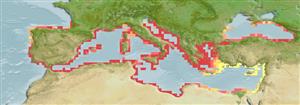>
Syngnathiformes (Pipefishes and seahorses) >
Syngnathidae (Pipefishes and seahorses) > Syngnathinae
Etymology: Syngnathus: Greek, syn, symphysis = grown together + Greek, gnathos = jaw (Ref. 45335).
More on author: Risso.
Environment: milieu / climate zone / depth range / distribution range
Ecologia
marino; acqua dolce; salmastro demersale; amphidromous? (Ref. 51243); distribuzione batimetrica 0 - 5 m (Ref. 6733). Subtropical; 45°N - 30°N, 10°W - 42°E
Eastern Atlantic: southern Biscay to Gibraltar, and also the Mediterranean and Black seas. Introduced and became established in the former USSR.
Size / Peso / Age
Maturity: Lm ? range ? - ? cm
Max length : 22.1 cm SL maschio/sesso non determinato; (Ref. 94846)
Euryhaline, found among detritus or vegetation over sand or mud, within a temperature range of 8° to 24°C. Probably an amphidromous species (Ref. 51243) but migratory behavior needs verification. Ovoviviparous (Ref. 205). The male carries the eggs in a brood pouch which is found under the tail (Ref. 205). Early free-living young measure 23 mm TL (Ref. 6733).
Females lay 10-60 eggs into a brood pouch on ventral surface of tail of males. Males fertilize the eggs as they enter the pouch. Eggs incubate in the male´s brood pouch for about 20-32 days, depending of temperature. (Ref.59043).
Dawson, C.E., 1986. Syngnathidae. p. 628-639. In P.J.P. Whitehead, M.-L. Bauchot, J.-C. Hureau, J. Nielsen and E. Tortonese (eds.) Fishes of the North-eastern Atlantic and the Mediterranean. Volume 2. Unesco, Paris. (Ref. 6733)
IUCN Red List Status (Ref. 130435)
Threat to humans
Harmless
Human uses
Informazioni ulteriori
BibliografiaAcquacolturaProfilo di acquacolturaVarietàGeneticaElectrophoresesEreditarietàMalattieElaborazioneNutrientsMass conversion
Strumenti
Special reports
Download XML
Fonti Internet
Estimates based on models
Preferred temperature (Ref.
123201): 15.2 - 21.4, mean 18.8 °C (based on 552 cells).
Phylogenetic diversity index (Ref.
82804): PD
50 = 0.5000 [Uniqueness, from 0.5 = low to 2.0 = high].
Bayesian length-weight: a=0.00025 (0.00020 - 0.00031), b=3.23 (3.18 - 3.28), in cm total length, based on LWR estimates for this species (Ref.
93245).
Trophic level (Ref.
69278): 3.2 ±0.40 se; based on food items.
Generation time: 1.5 ( na - na) years. Estimated as median ln(3)/K based on 1
growth studies.
Resilienza (Ref.
120179): Alto, tempo minimo di raddoppiamento della popolazione meno di 15 mesi (Preliminary K or Fecundity.).
Fishing Vulnerability (Ref.
59153): Moderate vulnerability (36 of 100).
Nutrients (Ref.
124155): Calcium = 206 [103, 448] mg/100g; Iron = 1.65 [0.97, 2.99] mg/100g; Protein = 18 [17, 19] %; Omega3 = 0.242 [0.130, 0.441] g/100g; Selenium = 15.7 [7.5, 33.6] μg/100g; VitaminA = 18.7 [6.9, 52.8] μg/100g; Zinc = 1.23 [0.82, 1.82] mg/100g (wet weight);
